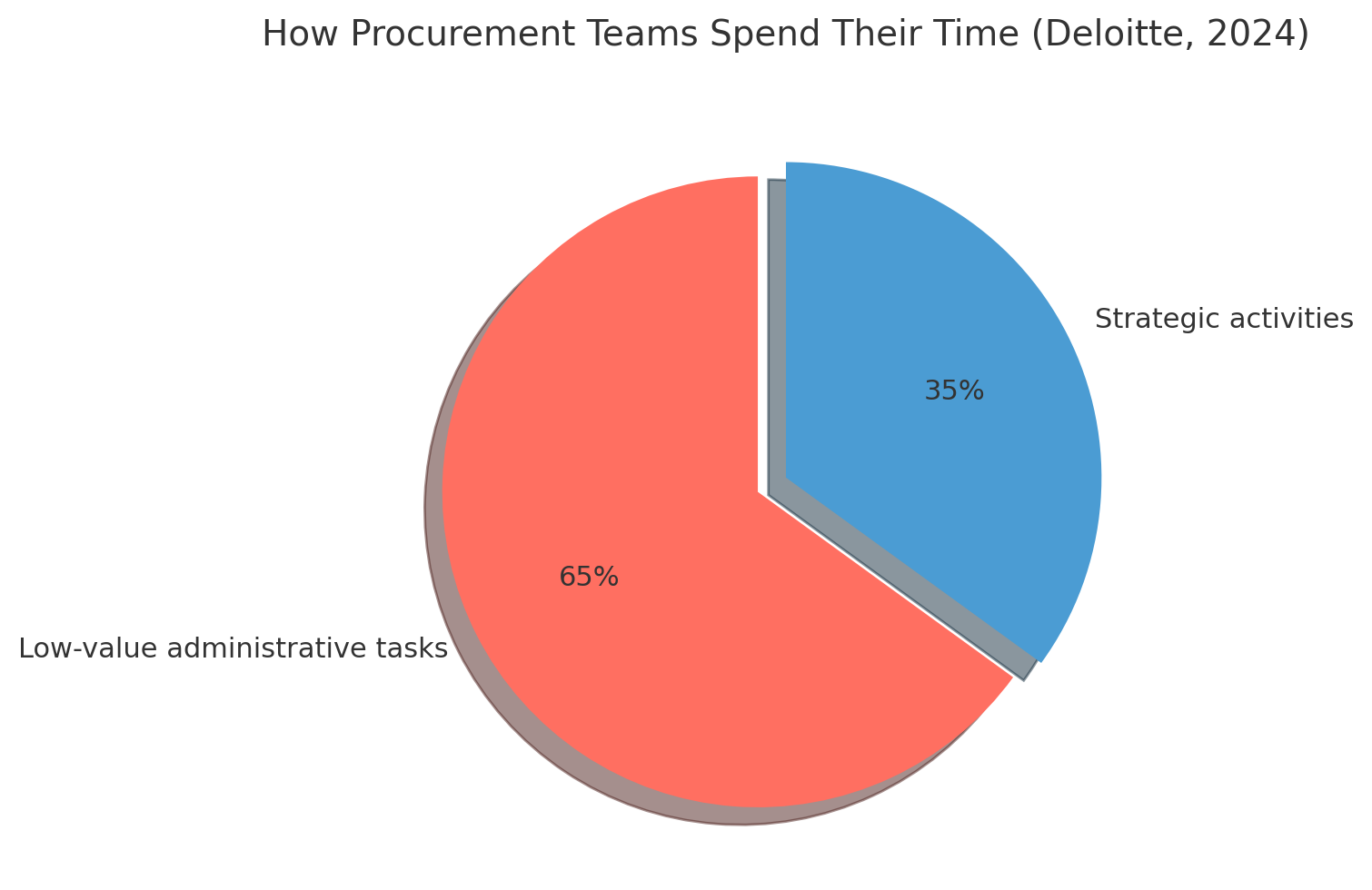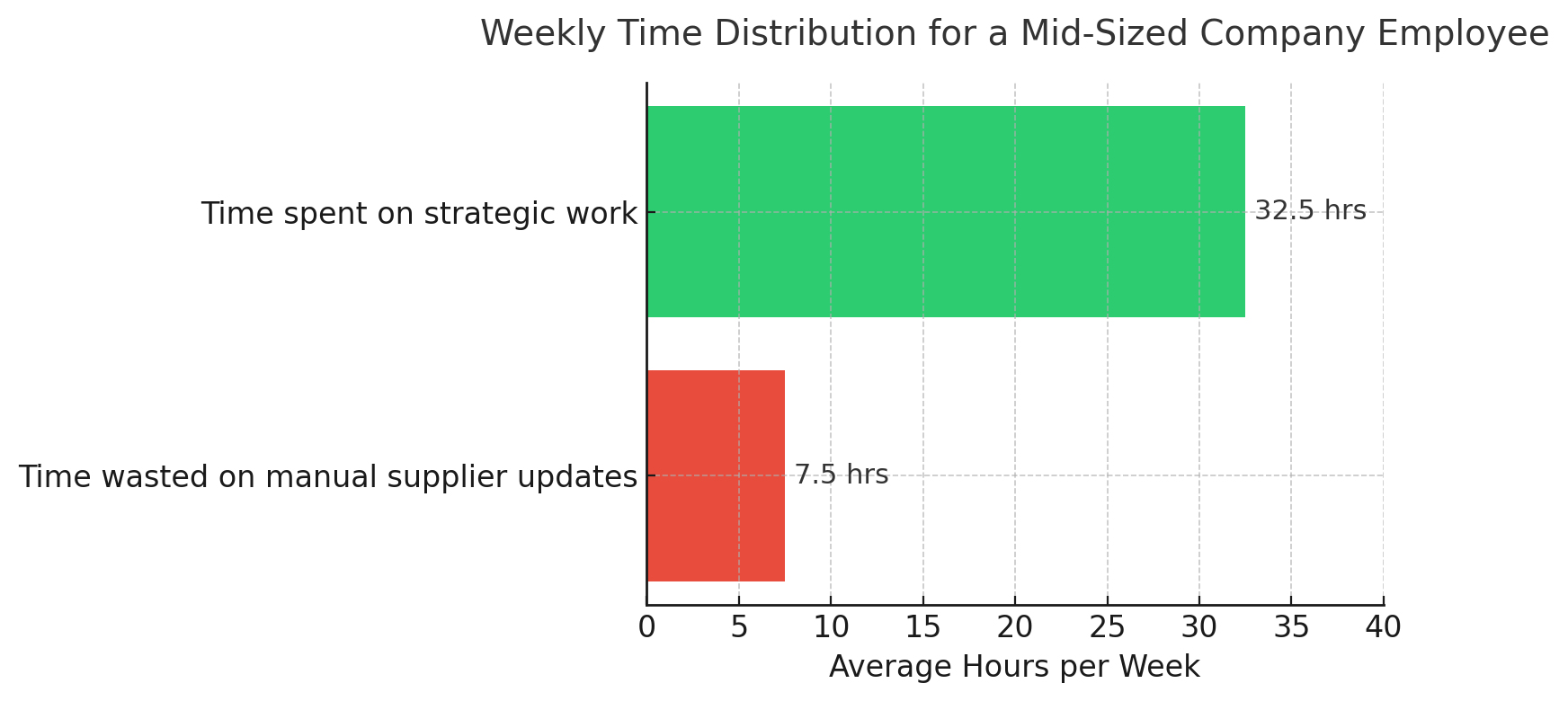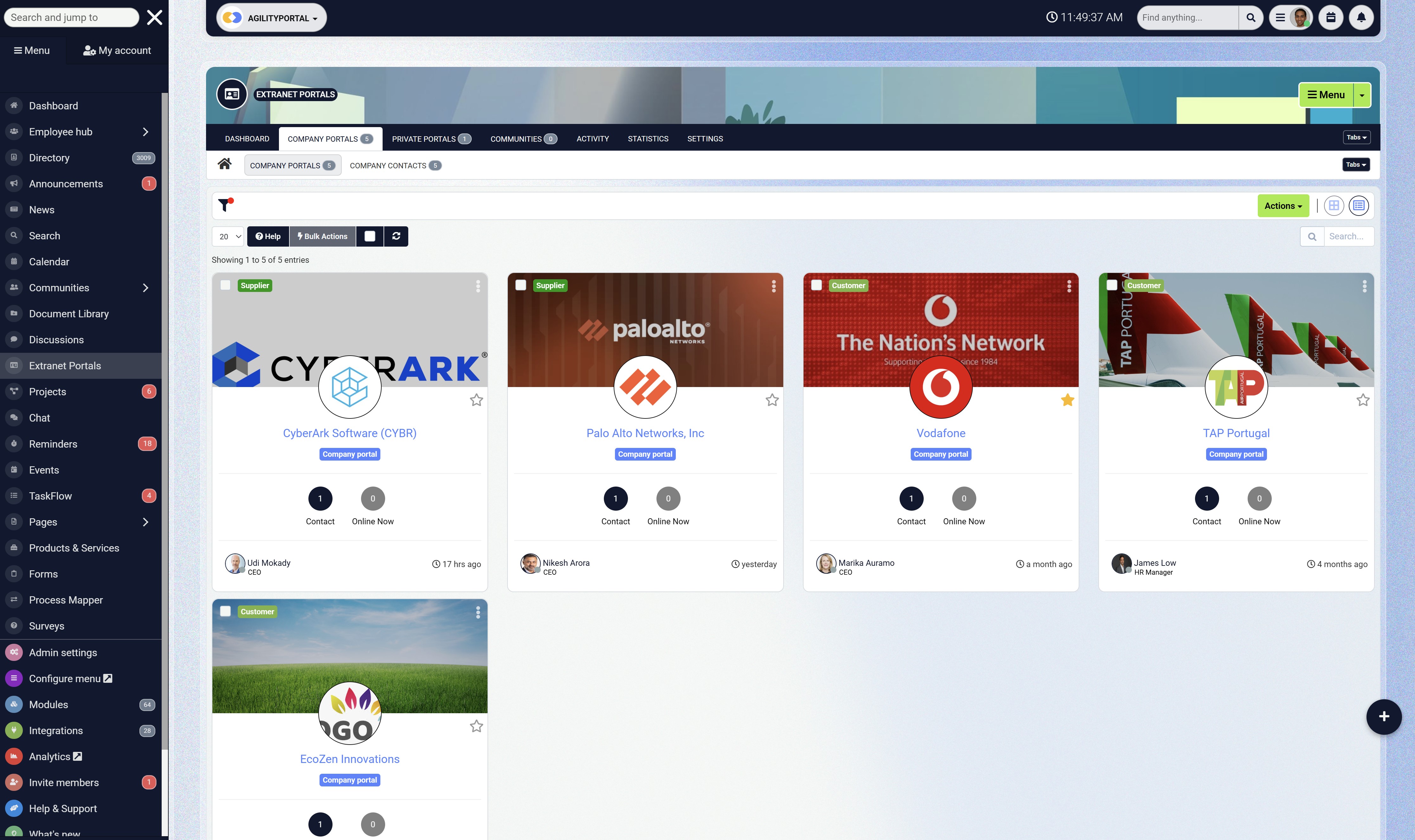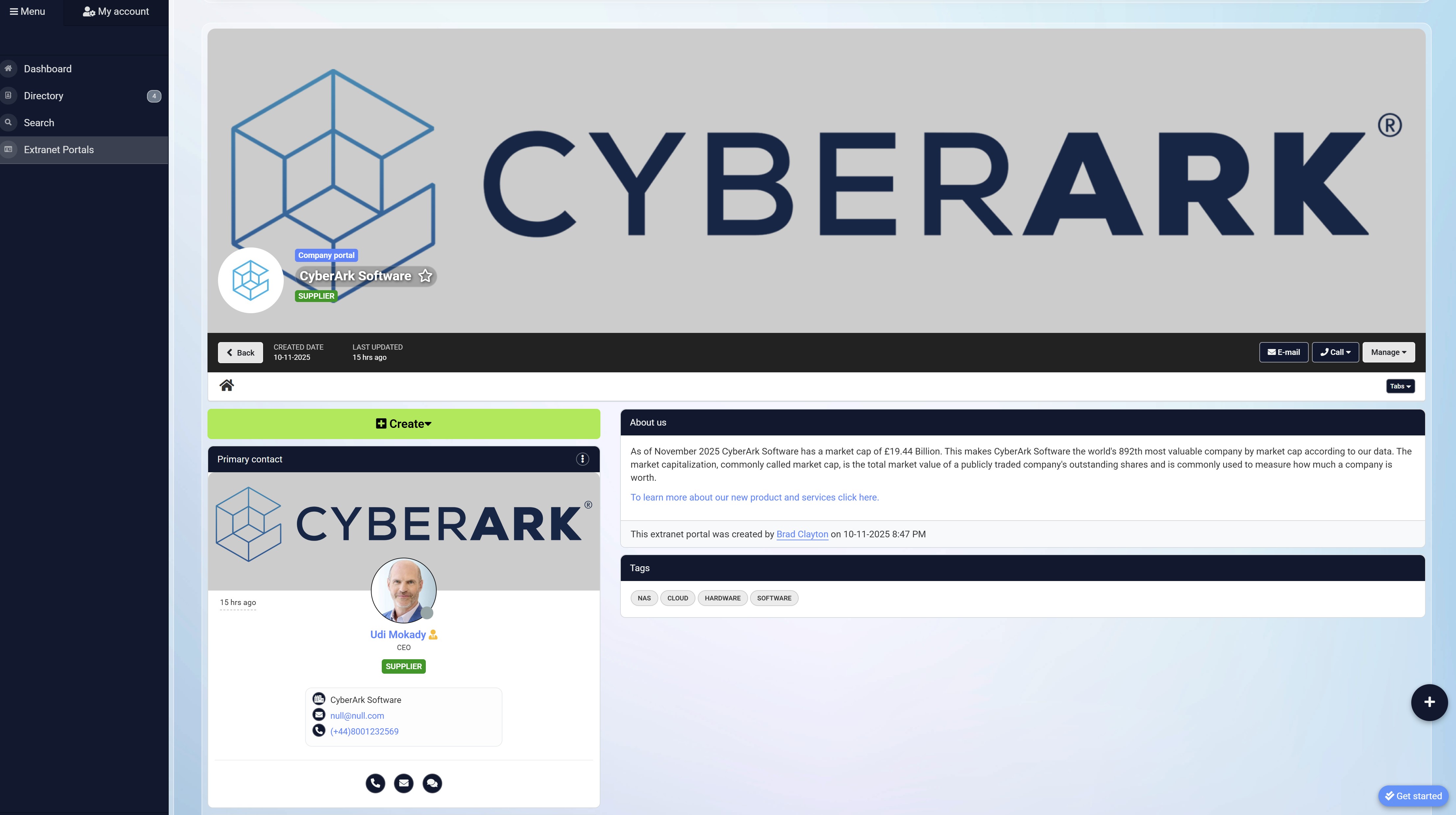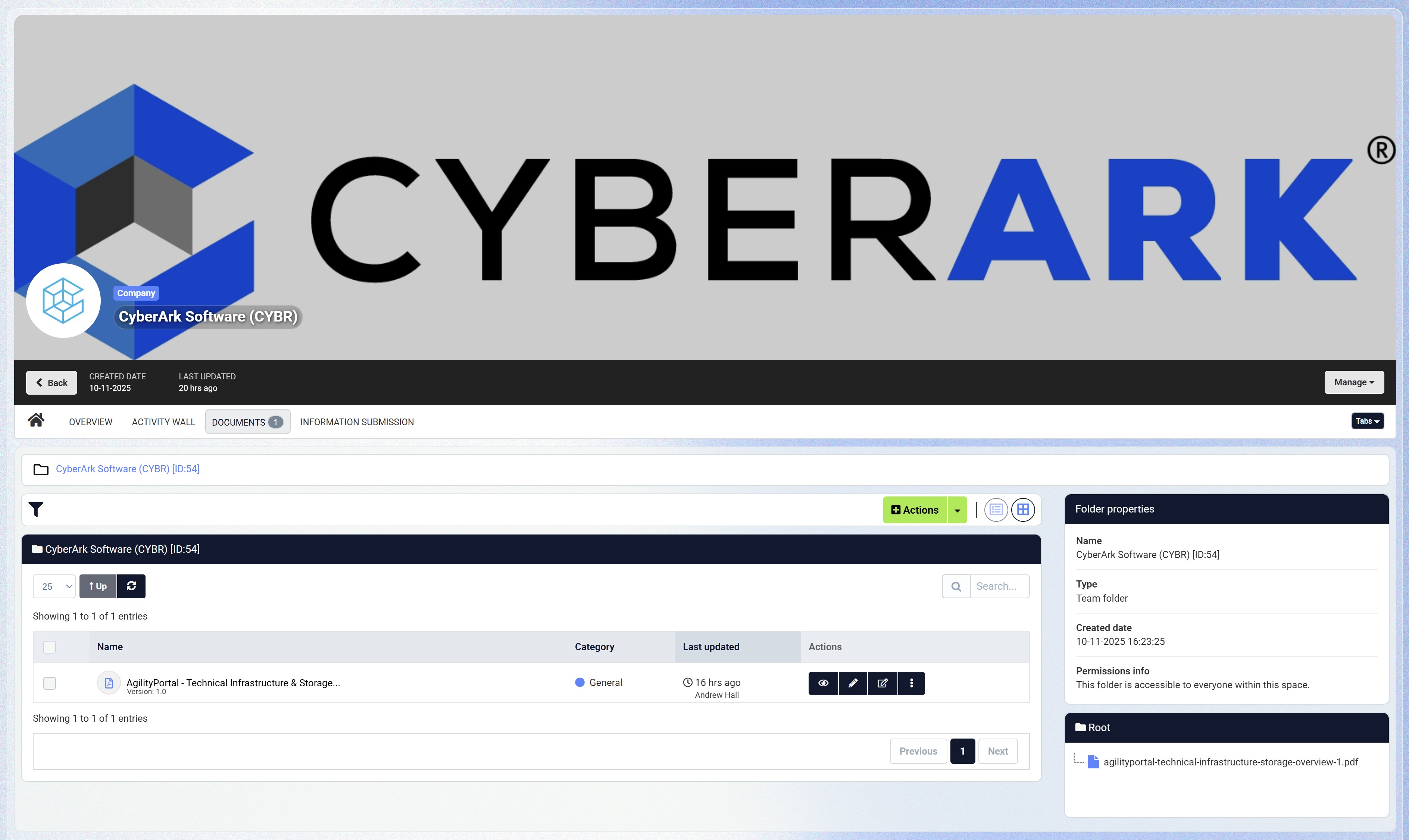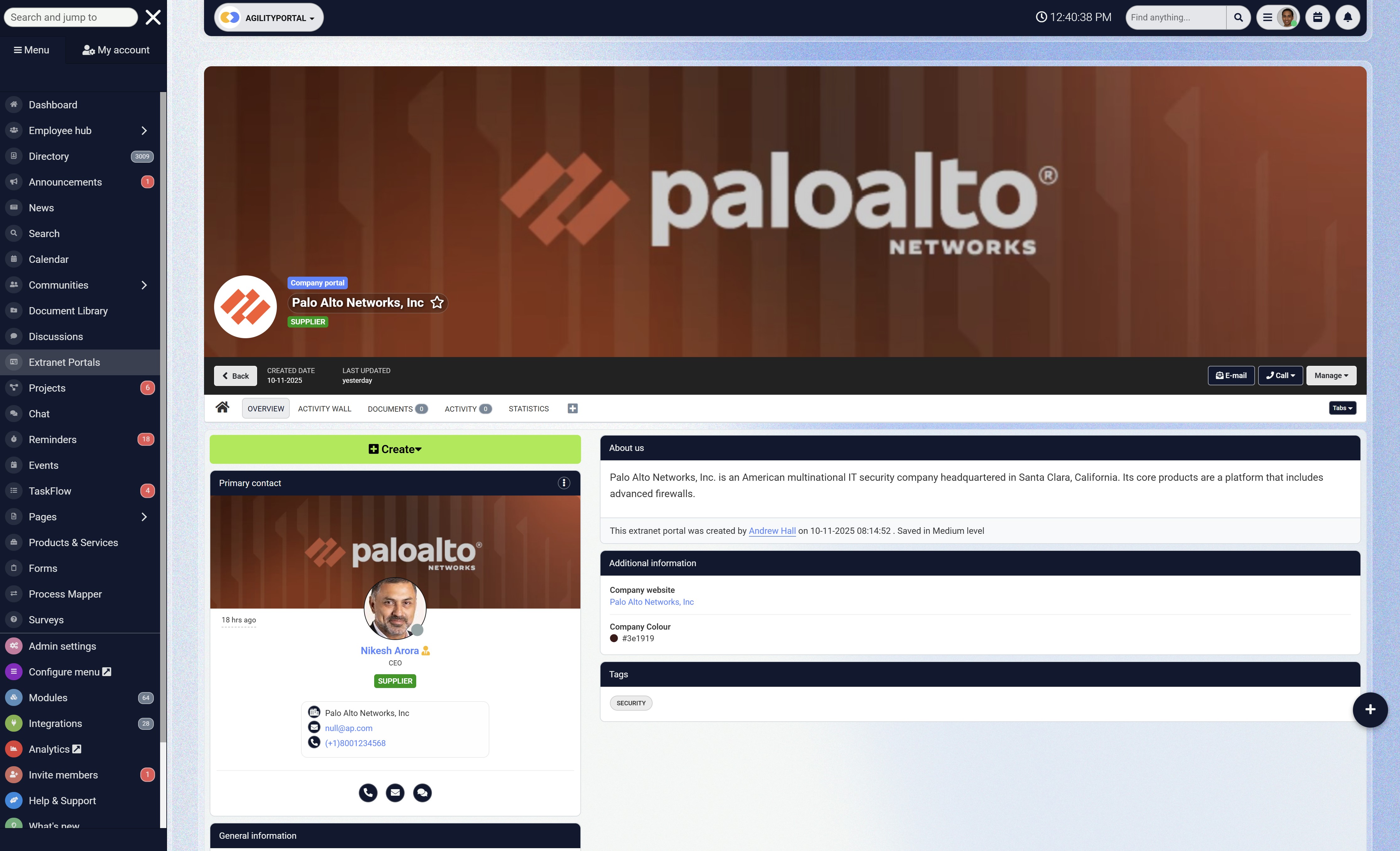Insight Blog
Agility’s perspectives on transforming the employee's experience throughout remote transformation using connected enterprise tools.
24 minutes reading time
(4851 words)
How to Pick a Supplier Portal That Actually Saves Time (vendor portal software) - A Complete Guide 2026
How to Pick a Supplier Portal That Actually Saves Time (vendor portal software) - A Complete Guide 2026
Struggling to keep suppliers updated? Learn how the right supplier portal automates product updates, saves time, and boosts team efficiency.
Let's be honest — managing supplier relationships can feel like a full-time job.
Between endless email threads, spreadsheets buried in shared drives, and manual updates that never seem to end, your team can lose hours every single week just trying to keep product and pricing information current.
According to a 2024 Deloitte study, procurement and supplier management teams spend up to 65% of their time on low-value administrative tasks, like chasing updates or distributing supplier communications.
That's time not spent on growth, strategy, or improving supplier performance — it's just busywork.
Business interactions with suppliers can be time-consuming, expensive, and frustrating — and that's exactly where a modern Supplier Portal (also known as a Vendor Portal) steps in.
Instead of juggling emails and phone calls, suppliers can log in, upload new product information, update incentives, or share training materials directly with your team.
The right supplier portal doesn't just simplify communication — it eliminates the bottlenecks that slow your business down.
By automating updates, connecting your suppliers directly to your internal teams, and syncing data with your financial and accounts payable systems, it saves hours of manual effort every week and keeps your entire supply chain in sync.
In this guide, we'll explore how to choose the right supplier portal for your business — one that genuinely saves time instead of creating more work — and how companies are using these platforms to transform vendor relationships, boost efficiency, and stay one step ahead.
Read this article:
Top 6 AI-Powered Project Management Tools To Use In 2023
Top 6 AI-Powered Project Management Tools To Use In 2023
The Hidden Time Trap in Supplier Communication
Picture this: your suppliers send new product details, price updates, and promotions through a mix of emails, attachments, and random chat messages.
You spend half your day forwarding information to the sales team, double-checking versions, and chasing missing data. Sound familiar? You're not alone.
Research by Deloitte shows that 60% of supplier management time is spent on administrative communication rather than building stronger supplier relationships or driving performance.
For a mid-sized company, that's an average of 5–10 hours per week wasted per employee just trying to stay up to date — time that could be better spent selling, strategizing, or improving operations.
This is where a Supplier Management System or Supplier Collaboration Portal changes the game. Instead of relying on endless back-and-forth communication, suppliers can log in, upload their own updates, share documents, and notify your team instantly. No middlemen. No delay.
Without a centralized supplier portal, every update becomes a mini project — tracking versions, copying data into spreadsheets, and manually informing everyone who needs to know.
Over time, these inefficiencies stack up: outdated product information, missed launches, and frustrated teams who feel constantly behind.
A modern Supplier Collaboration Portal solves these bottlenecks by creating a single source of truth — a shared digital workspace where suppliers and internal teams work in real time.
It reduces manual admin, prevents costly mistakes, and most importantly, gives you back the time your business is losing to fragmented communication.
Next, let's look at how a Supplier Portal not only simplifies the process but actually helps you reclaim those lost hours and turn supplier communication into a competitive advantage
What Is a Supplier Portal (and Why It's a Game-Changer for Time Savings)
A Supplier Portal — sometimes called a Vendor Portal — is a secure online platform that connects your business directly with your suppliers, eliminating the endless back-and-forth of emails, spreadsheets, and phone calls.
Its also know as:
- supplier extranet
- supplier portal
- client management portal
- vendor extranet
- vendor portal
- partner extranet
- partner portal
- client extranet
- client portal
- customer extranet
- customer portal
It acts as a partner collaboration portal, streamlining everything from product updates to purchase orders in one centralized location.
At its core, a supplier portal efficiently handles shared business processes through a simple web interface.
Instead of relying on manual client communication, your suppliers can log in to the portal anytime to update product information, upload documents, or share promotional content — while your internal teams can instantly view and approve changes.
Modern supplier portals are built to save time and simplify collaboration.
Think of it as a Supplier Collaboration Portal that empowers suppliers to manage their own data while giving your team full visibility and control.
Supplier portals have some indispensable features, including:
- 24×7 access to real-time data – Suppliers and internal teams can check stock levels, pricing, or order status anytime.
- Ability to update supplier information – Contact details, product catalogs, certifications, and pricing can be updated instantly without involving your admin team.
- View history of transactions – Every interaction and document exchange is logged, ensuring transparency and accountability across all supplier relationships.
By centralizing communication and automating manual tasks, a Supplier Portal frees your team from time-consuming coordination, reduces human error, and ensures that your entire supply chain stays aligned — no matter how many suppliers you manage.
Supplier portals like those used by companies such as Dell and Unilever allow vendors to securely share product details, invoices, and training materials directly with internal teams.
A good example is AgilityPortal's Extranet which offers the same streamlined experience — enabling suppliers to manage information, update contacts, and collaborate with employees in one secure, unified platform.
In short: your suppliers do the work — you stay informed.
Next, we'll dive into the clear warning signs that your business is losing valuable time by not using a supplier portal.
Signs You're Wasting Time Without a Supplier Portal
Managing supplier relationships without the right tools is like trying to run a marathon in heavy boots — slow, frustrating, and inefficient.
If any of these signs sound familiar, your business is likely wasting valuable time every week.
1. You're drowning in email threads and attachments
Imagine this: your supplier sends a new product catalog on Monday, then follows up on Wednesday with "the latest version," and by Friday there's another update attached to a reply-all email with 12 people CC'd.
Now multiply that by 20 suppliers.
By the end of the week, your inbox is a mess of conflicting attachments, outdated price lists, and endless "please confirm receipt" messages.
Your sales team ends up using the wrong file, procurement can't find the final approved version, and finance is still referencing last quarter's pricing.
Without a secure partner portal to centralize communication and version control, even a simple update turns into an administrative nightmare.
A portal lets suppliers upload files once, tag them properly, and notify everyone automatically — no more digging through endless email chains to figure out what's current.
2. You're still using Excel spreadsheets to manage suppliers
Many businesses still manage hundreds of suppliers in one massive Excel sheet — tabs for pricing, contacts, and product codes.
But one wrong cell or version saved locally can throw the entire system off.
For example, a procurement manager updates the supplier contact list but forgets to share the new file with the finance team.
Suddenly, invoices go to the wrong email address, delaying payments and damaging relationships.
A supplier communication portal replaces fragile spreadsheets with a real-time, web-based interface where supplier data is always accurate, accessible, and synced across departments.
You'll never have to worry about which version is "the latest" again.
3. New supplier products take weeks to reach your sales floor
A supplier launches a new product line on January 1st. But between collecting specs, updating marketing materials, and waiting for internal approvals, it doesn't reach your sales team until February.
By then, competitors have already capitalized.
A vendor self-service portal solves this by automating product updates and alerts.
When suppliers upload new product data, your marketing and sales teams get instant access — cutting that month-long delay down to hours.
The faster your team knows, the faster you sell.
4. You rely on one person to manage all supplier data manually
Let's say Lisa from procurement handles all supplier communications.
Every update — pricing sheets, compliance forms, catalogs — passes through her inbox.
When she's out sick or on vacation, everything grinds to a halt.
That dependency is risky and inefficient.
A Supplier Portal eliminates single points of failure by giving each supplier self-service access to upload and maintain their own information, while your team can monitor progress in one dashboard.
Lisa can finally focus on strategy instead of chasing emails.
5. Sales teams are working with outdated product information
Your sales rep confidently pitches a new offer to a client, only to discover that the supplier changed the price two weeks ago — but the update never reached them.
That one mistake costs credibility and might even lose the deal.
This happens because product or pricing changes get stuck in inboxes or missed entirely.
With a Supplier Collaboration Portal, suppliers update information directly in the system, and sales teams see the changes in real time — not weeks later. Everyone stays aligned, and costly miscommunications disappear.
When you look at it this way, it's clear — email chains, manual updates, and Excel sheets might feel familiar, but they're quietly draining your team's most valuable resource: time.
A modern Supplier Portal or Vendor Portal puts that time back where it belongs — helping your people focus on selling, sourcing, and scaling, not chasing updates.
How the Right Supplier Portal Saves You Hours Each Week
When it comes to supplier communication, the difference between chaos and control often comes down to automation.
The right secure partner portal doesn't just connect you with suppliers — it empowers them to take responsibility for keeping information accurate and up to date, while your team focuses on strategy instead of admin.
Here's how it saves you hours every single week:
1. Self-Service Supplier Updates
In the old setup, every product change or pricing adjustment required a manual email exchange.
Multiply that by dozens of suppliers, and you've got a full-time job just updating information.
With a modern Supplier Collaboration Portal, suppliers can log in directly, upload product updates, change availability, and attach supporting documents — all without waiting on your team.
You control permissions, review updates instantly, and approve with one click. That means no bottlenecks, no chasing, and no "who has the latest file?" confusion.
Example: A supplier adds a new training brochure for their latest product line.
Instead of your marketing team re-uploading and notifying everyone, the supplier does it once, and the content appears in your portal instantly for all relevant departments.
2. Automated Notifications
Manual reminders are productivity killers. If your sales team needs to be told about every supplier update, someone's job becomes "email dispatcher."
A Supplier Portal automates that. Whenever a supplier uploads new content or changes pricing, instant notifications are sent to the right teams — procurement, finance, sales, or compliance — without anyone lifting a finger.
Example: The moment a supplier updates pricing, your sales reps get an automatic alert and can adjust quotes immediately. No delays. No missed opportunities.
3. Integrated Workflows
Disconnected systems are a silent time drain. Without integration, your team ends up re-entering supplier data into CRM, ERP, or finance software — wasting time and increasing error risk.
The best Supplier Management Systems integrate directly with your existing tools, syncing supplier data in real time.
That means when a supplier changes their contact, uploads a new certification, or updates inventory, it flows straight into your business systems automatically.
Example: A supplier updates their product catalog in your portal — within minutes, it's reflected in your CRM for sales and in your ERP for procurement. One update, everywhere it needs to be.
4. Centralized Compliance Documents
Chasing down certificates, insurance documents, or audit forms is one of the biggest time drains in supplier management. Expired or missing documents can delay projects and create compliance risks.
With a Supplier Portal, every document is stored, tracked, and version-controlled in one secure place. Suppliers upload compliance materials themselves, and your system can automatically flag upcoming expirations before they become a problem.
Example: Instead of scrambling before an audit to find the latest ISO certificate, you simply search the portal — it's right there, date-stamped and ready to download.
By combining self-service, automation, integration, and centralized control, a Supplier Portal eliminates repetitive admin tasks and gives your team back hours every week.
The result? Faster collaboration, fewer mistakes, and a business that runs like clockwork — not like a never-ending inbox.
Read this article:
Internet Intranet Extranet: Key Differences
Internet Intranet Extranet: Key Differences
How the Right Supplier Portal Saves You Hours Each Week
When you look closely at how supplier communication happens in most organizations, one thing becomes painfully clear: time is slipping away in small, invisible chunks.
According to Deloitte's 2024 Global CPO Survey, procurement teams spend up to 65% of their working hours on repetitive administrative tasks — following up on emails, updating spreadsheets, and tracking down supplier information.
That's roughly 26 hours per week per employee lost to work that could be automated.
A Supplier Portal eliminates that waste by centralizing updates, automating communication, and empowering suppliers to manage their own data.
Here's how the time adds up:
| Task | Manual Method | Average Time Wasted per Week | With Supplier Portal | Time Saved |
| Product Updates | Chasing emails, version confusion, and spreadsheet edits across multiple suppliers | 5–8 hours | Suppliers upload product data directly with instant version control | 80–90% less time |
| Notifications | Admin manually informs sales, finance, and procurement of every change | 5–8 hours | Automated alerts notify relevant teams in real time | 100% automated |
| Document Tracking | Searching shared drives or email for certificates and forms | 4–6 hours | Centralized repository with expiry reminders and search filters | 100% automated |
| Data Sync | Copy-pasting data between ERP, CRM, and spreadsheets | 2–3 hours | Real-time sync between connected systems | Eliminates duplicate work |
| Supplier Communication | Following up for missing updates or approvals | 3–4 hours | Two-way communication inside the portal | 70% less back-and-forth |
Total Time Saved per Employee: ~20–25 hours per week — that's an entire workday back every single week.
If your procurement team has 10 members each saving 20 hours per week, that's 200 hours reclaimed weekly — or 10,000+ hours per year.
At an average loaded cost of £30/hour, that's a £300,000 annual efficiency gain, not counting faster sales cycles and fewer errors.
A mid-sized electronics distributor managing 80 suppliers switched from Excel and email to a Supplier Collaboration Portal.
Within three months:- Time spent updating supplier information dropped by 78%.
- Order processing errors decreased by 42%.
- Supplier satisfaction scores rose by 35% (measured through quarterly surveys).
A Supplier Portal doesn't just make processes smoother — it reclaims hours, reduces costs, and accelerates collaboration across every department.
Instead of spending time on repetitive admin, your team focuses on what actually grows the business: supplier strategy, negotiation, and innovation.
Choosing a Supplier Portal That Actually Works (and Doesn't Add Complexity)
Not all partner extranets are created equal. Some promise efficiency but end up adding more admin work and technical headaches than they remove.
The goal is to find a system that works for your team — not one your team has to work around.
The right portal should make communication seamless, automate updates, and empower both suppliers and employees without requiring constant IT support.
Here's what to look for — and what to avoid — when selecting a client extranet or client portal that genuinely saves time.
Must-Have Features for Time Savings
- Easy Supplier Onboarding - Your suppliers shouldn't need a manual to start using your portal. Look for platforms with simple registration links, guided setup steps, and prebuilt templates. The faster a supplier can onboard, the quicker you see value. Example: A supplier gets an invite, uploads their catalog in minutes, and is live within the same day — not waiting two weeks for IT to approve credentials.
- Role-Based Permissions - Security and clarity go hand in hand. With role-based permissions, your procurement team, finance staff, and suppliers only see what's relevant to them. This minimizes confusion and protects sensitive financial data.
- Product Update Feeds or Announcements - Suppliers should be able to share new products, promotions, or training updates directly in the portal — just like posting to a feed. Employees can subscribe to updates from specific suppliers or product categories, keeping information flowing without email overload.
- Integration With Sales and Communication Tools - A time-saving Supplier Management System must integrate smoothly with the tools you already use — CRM systems like HubSpot or Salesforce, communication tools like Microsoft Teams or Slack, and ERP platforms for procurement. Integration ensures updates appear everywhere they're needed, automatically.
- Analytics Dashboard (to Track Engagement) - You can't improve what you don't measure. A good Supplier Collaboration Portal provides dashboards showing how many suppliers are active, which updates are being viewed, and who's lagging behind. This visibility helps your team proactively address communication gaps and supplier performance.
Avoid These Red Flags
- Requires Heavy IT Involvement - If your supplier portal needs custom coding or IT intervention for every update, it's not saving time — it's stealing it. Modern portals should be cloud-based, intuitive, and manageable by your internal teams.
- Limited External User Access - A common mistake is choosing a system that only works well for internal staff. Your suppliers need secure, self-service access without jumping through hoops. Without that, you're right back to managing updates via email.
- No Real-Time Notifications - Delays kill productivity. A portal without automated alerts or real-time notifications defeats the purpose of having one. Teams need to know immediately when suppliers update pricing, upload documents, or add new content.
- Clunky Supplier Registration Process - If onboarding feels like an obstacle course — multiple approvals, confusing forms, or long wait times — suppliers will avoid using the portal altogether. Keep it fast, simple, and mobile-friendly.
A Supplier Portal should simplify, not complicate. When chosen wisely, it becomes a living hub of collaboration — where suppliers take ownership of their data, your teams gain real-time visibility, and everyone saves time without sacrificing control.
Benefits of a Supplier Portal
Pairing a digital supplier management system with modern accounts payable automation software transforms how finance teams operate.
It eliminates paper-based processes for stronger sustainability, drastically cuts data entry mistakes, and reduces the constant drain on AP resources by shifting repetitive tasks to vendors.
Streamlined Workflows and Real-Time AccuracyBy transferring part of the workflow to suppliers through a secure, self-service platform, your business gains tighter control and accuracy over every transaction. Documents are uploaded directly by vendors, automatically organized, and instantly visible to your finance team. Payment disputes, invoice approvals, and real-time status tracking happen inside the system — no more scattered emails or follow-up calls.
Freeing Accounts Payable From the "Help Desk" TrapIn many organizations, AP specialists spend much of their day fielding questions like "Has my invoice been processed?" or "When will payment go out?" Without an automated vendor payment communication system, suppliers are left to chase updates manually — turning skilled finance professionals into de facto customer service reps. A self-service supplier interface changes that by letting vendors check payment status, download remittance details, and view transaction history on demand, giving your AP team time to focus on strategic priorities.
Built-In Fraud Prevention and TransparencyThe right automated supplier platform doesn't just process payments — it also safeguards them.
Integrated fraud-detection tools can flag suspicious or duplicate vendors before disbursements occur, helping finance teams prevent unnecessary losses while maintaining full visibility into every transaction.
When your vendor collaboration portal connects directly with your ERP or cloud accounting system, data flows automatically between modules — no duplicate entries or manual reconciliations.
The result: faster processing, greater efficiency, and measurable cost savings across the entire accounts payable function.
Because it's cloud-based, your online supplier platform provides secure access anytime, anywhere. Vendors can upload invoices, update information, and track payments from any device — all while your finance team retains total control over permissions and audit trails.
Simplifying Supplier Payments and ReportingA centralized supplier payment hub makes reconciliation and reporting effortless. Payment data, documents, and communications all live in one place — helping finance leaders make informed, real-time decisions without hunting through spreadsheets or inboxes.
A Shift as Big as Online BankingJust as ATMs and online banking revolutionized personal finance, automated supplier management platforms are reshaping B2B relationships.
They bring suppliers the same level of convenience, transparency, and control — and give businesses the efficiency, accuracy, and sustainability today's finance operations demand.
Case Study: How One Buyer Cut Supplier Update Time by 70% Using a Cloud-Based Supplier Collaboration Platform
The Customer: A mid-sized multi-channel distributor in the UK, "ElectroMart," wanted to reduce the time spent managing supplier updates and improve visibility across departments.
The Problem:
ElectroMart relied on manual supplier update workflows, Excel sheets, and endless email threads to manage 500+ suppliers.
- Procurement spent around 16 hours per week chasing supplier information.
- Sales often worked from outdated data for up to three days per cycle.
- Onboarding new suppliers took nearly a week, delaying product launches.
These bottlenecks were costing time, money, and credibility — all because their systems lacked a centralized supplier management solution.
The Solution: Implementing a Cloud-Based Supplier Collaboration Platform
ElectroMart decided to deploy a cloud-based supplier collaboration platform designed to automate vendor communication, streamline onboarding, and sync with their ERP and CRM systems.
Key transactional actions included:
- Purchased a self-service supplier management tool with real-time update capabilities.
- Integrated the platform with their ERP and CRM systems to automate product data synchronization.
- Configured automated alerts and workflows to keep procurement, sales, and finance aligned.
- Upgraded to a premium supplier onboarding module that reduced registration time from 5 days to under 24 hours.
Within weeks, suppliers were logging in directly through the vendor communication portal to upload new product specs, pricing updates, and promotional materials — no manual input required.
The Results: Quantifiable ROI and Efficiency Gains
After implementing the supplier relationship management software, ElectroMart reported:
- 70% reduction in supplier update time.
- 50% fewer pricing and product data errors.
- 40% drop in internal email volume related to supplier updates.
- Faster go-to-market cycles — product launches now reach the sales team within hours, not weeks.
- Estimated annual labor savings of £180,000+ from automation.
Why This Matters:
By choosing to adopt an automated vendor communication system instead of patching manual processes, ElectroMart turned supplier management into a streamlined, data-driven workflow.
This case shows how investing in a supplier collaboration solution delivers measurable ROI, improves supplier relationships, and empowers teams with real-time visibility — exactly what modern procurement leaders are searching for when they compare supplier management platforms or request a demo of a vendor automation tool like AgilityPortal.
The ROI of Investing in a Self-Service Vendor Communication Portal for Procurement Teams
Putting money into a self-service vendor communication portal for procurement teams isn't just about convenience — it's about measurable return.
Every manual process you automate translates directly into time recovered, errors cut, and budget freed up.
Take this example: the average procurement or operations professional spends around 20 hours each week managing supplier updates manually.
At a loaded cost of about £30/hour, that's roughly £600/week or about £31,000/year per person.
Now imagine replacing that with an automated system where suppliers log in directly, upload product data and pricing, and your team gets instant notifications.
Many companies reclaim 70-80% of that time, which means roughly £21,000-£25,000 saved per person, per year. For a 10-person procurement team, that's £210,000-£250,000 in annual savings, before factoring faster product launches or fewer reconciliation errors.
Every delay in supplier communication slows sales and adds cost.
With an automated "supplier update system for product launches," companies have slashed delay times from weeks to days — accelerating go-to-market and boosting revenue.
Manual processes also invite mistakes: studies show organisations using integrated vendor portals reduce data-entry errors by up to 50% and avoid costly rework.
Meanwhile, automating compliance and document tracking with a "web-based vendor onboarding and document tracking portal" has helped firms cut follow-up time by ~60% and audit prep hours by ~75%.
In short: by switching to a high-efficiency "real-time supplier collaboration workspace for enterprise procurement," you don't just streamline processes — you reclaim time, reduce cost, and unlock strategic focus for your team.
Getting Started - Your 3-Step Plan to Modernize Supplier Communication
You don't need to overhaul your entire operation overnight to see results.
A smarter, phased rollout helps you prove ROI fast and build confidence among internal teams and suppliers alike.
Here's how to get started:
Step 1: Identify Communication Bottlenecks
Start by mapping where supplier communication breaks down today — endless email chains, missed product updates, or duplicate data entry between departments.
Document how much time your procurement or accounts payable teams spend on these repetitive tasks each week.
This baseline will help you measure the true impact once automation kicks in.
Step 2: Decide What Can Be Automated or Self-Managed
Next, pinpoint the processes that don't need human handling.
Examples include supplier onboarding, invoice uploads, product updates, and document renewals.
With a self-service supplier collaboration system, suppliers can manage these directly, while your team focuses on high-value strategic work.
Tip: Choose automation tools that integrate easily with your ERP or CRM to avoid creating new data silos.
Step 3: Launch a Pilot With Key Suppliers
Don't wait for perfection — start small.
Pick one or two trusted suppliers and invite them to use your new digital supplier workspace.
Monitor engagement, track the time saved, and gather feedback from both sides.
Most companies see measurable efficiency gains within the first month. Once the pilot works smoothly, scale the system across your full supplier network.
Ready to See It in Action?
Discover how AgilityPortal can streamline supplier updates, automate communication, and give your teams valuable hours back each week.
👉 Book a 14-day free trial and experience how easy it is to modernize supplier management.
Frequently Asked Questions About Vendor and Supplier Portals
What is a vendor portal?
A vendor portal is a secure online platform that allows suppliers to interact directly with your company.
Through the portal, vendors can upload invoices, update product details, track payment status, and manage compliance documents.
It replaces time-consuming email threads and manual data entry with real-time collaboration — reducing errors and administrative overhead.
Modern systems like AgilityPortal's supplier management workspace also integrate with ERP and CRM tools, keeping all supplier data synchronized and accessible.
What is vendor login?
A vendor login is the secure access point suppliers use to enter your company's digital supplier platform.
Once logged in, they can view real-time data such as purchase orders, invoice status, and payment history.
It acts as the gateway to your vendor communication system, ensuring each supplier sees only the data relevant to them, maintaining both transparency and security.
What is a customer vendor portal?
A customer vendor portal is an extended version of a supplier portal that benefits both customers and vendors.
It provides a shared space where businesses can exchange documents, track transactions, and collaborate on orders or projects in real time.
Think of it as a digital collaboration hub — customers gain visibility into supply chain activities, while vendors gain a structured, automated channel to manage their business relationships efficiently.
How do you find your vendor?
To find and onboard the right vendor, businesses often use a digital supplier discovery or onboarding system built into their vendor portal.
This allows companies to evaluate suppliers based on compliance documents, performance metrics, and product data before establishing a partnership.
Once verified, the vendor gains access via a secure login and begins sharing updates, invoices, and credentials through the same system — making supplier discovery, onboarding, and management a seamless process.
Final Thoughts
A well-designed vendor and supplier management portal does more than just organize information — it transforms how your business collaborates.
By giving suppliers secure access to upload, track, and manage data, you create a transparent, efficient ecosystem that reduces errors, speeds up payments, and saves hours of manual work every week.
In short, a supplier portal is more than a communication tool — it's an efficiency engine that empowers vendors, streamlines workflows, and frees your internal teams to focus on what matters most: growth and innovation.
Categories
Blog
(2620)
Business Management
(320)
Employee Engagement
(210)
Digital Transformation
(175)
Growth
(119)
Intranets
(119)
Remote Work
(61)
Sales
(48)
Collaboration
(37)
Culture
(29)
Project management
(29)
Customer Experience
(26)
Knowledge Management
(21)
Leadership
(20)
Comparisons
(6)
News
(1)
Ready to learn more? 👍
One platform to optimize, manage and track all of your teams. Your new digital workplace is a click away. 🚀
Free for 14 days, no credit card required.



